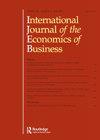印度的并购动机是什么?
IF 0.9
Q3 BUSINESS
International Journal of the Economics of Business
Pub Date : 2023-09-02
DOI:10.1080/13571516.2023.2256037
引用次数: 0
摘要
摘要本文试图探讨印度企业并购战略背后的动因。本文涵盖了1998年至2017年二十年的国内活动,研究了收购公司和被收购公司的公司层面决定因素,以分析合并动机。Logit和离散时间风险模型的结果表明,技术生产率和财务生产率较高的企业更有可能进行收购。另一方面,未来有增长潜力,但目前因低利润或亏损而陷入困境的企业更有可能被收购。不积极参与研究活动的企业管理层也有可能被替换。因此,这篇文章的发现表明,印度公司正在利用合并来扩张和提高效率。关键词:并购公司目标逻辑与生存分析印度ajel分类:G34L2披露声明作者未报告潜在利益冲突。注1本统计数据是在剔除金融服务后计算的。继之前的文献(Andrade and Stafford Citation2004;Ali-Yrkkö, Hyytinen, and Pajarinen Citation2005),由于会计和金融业务性质的巨大差异,金融行业被排除在外正确的审查意味着受试者在整个研究过程中幸存下来。在整个样本期间,该公司既没有成为收购方,也没有被收购,因此,直到该公司参与合并的期间,才对其进行审查这里的控制组的定义只包括未合并的企业,不包括目标企业h本文章由计算机程序翻译,如有差异,请以英文原文为准。
What Motivates Mergers and Acquisitions in India?
AbstractThis paper attempts to explore the motives behind merger and acquisition strategy of Indian corporates. Covering the domestic activity over two decades, 1998--2017, the firm-level determinants of acquiring and acquired firms are studied to analyze the merger motives. The results from Logit and discrete-time hazard model show that firms with higher technological and financial productivity are more likely to go for acquisitions. On the other hand, firms that have potential to grow in the future but are struggling at present owing to low profits or losses are more likely to be acquired. The managements of firms that are not actively involved in research activities are also likely to be replaced. The findings of the article, therefore, suggest that Indian firms are using mergers for expansionary and efficiency-enhancing motives.Keywords: Mergersacquisitionsfirm objectiveslogit and survival analysisIndiaJEL CLASSIFICATION: G34L2 Disclosure statementNo potential conflict of interest was reported by the author(s).Notes1 This statistic has been calculated after excluding the financial services. Following the previous literature (Andrade and Stafford Citation2004; Ali-Yrkkö, Hyytinen, and Pajarinen Citation2005), the financial industry is excluded because of the huge differences in accounting and nature of the financial business.2 Right censoring means that subject has survived through the entire duration of the study. The firm has neither become an acquirer nor been acquired throughout the sample period and therefore, it has not been examined until the duration it becomes involved in a merger.3 The definition of control group here includes non-merging firms only and not the target firms.4 The USD value is based on the exchange rate that prevailed in March, 2023.5 Hüschelrath and Smuda (Citation2013) observed a significant and positive impact of cartels’ breakdown on merger activity, studying cartel cases decided by the European Commission between 2000 and 2011, and a detailed data set of worldwide merger activity.6 They argue that high-insider ownership is a classic feature of Indian businesses. Most Indian firms are largely organized as business groups or family firms, with promoters holding majority stake. This encourages more cash deals and discourages mergers driven by market mis-valuations.7 The likelihood of being an acquirer reaches its maximum for firms with sales growth of around 5%.8 The likelihood of being acquired reaches its maximum for firms with total assets of around Rs 7.3 million.
求助全文
通过发布文献求助,成功后即可免费获取论文全文。
去求助
来源期刊
CiteScore
2.60
自引率
8.30%
发文量
9
期刊介绍:
International Journal of the Economics of Business presents original, peer reviewed research in economics that is clearly applicable to business or related public policy problems or issues. The term "business" is used in its widest sense to encompass both public and private sector—governmental, private non-profit and cooperative organizations, as well as profit-seeking enterprises. International Journal of the Economics of Business carries papers relating to three main spheres: The organization—to analyse and aid decision making and the internal organization of the business; The industry—to analyse how businesses interact and evolve within and across industries.

 求助内容:
求助内容: 应助结果提醒方式:
应助结果提醒方式:


